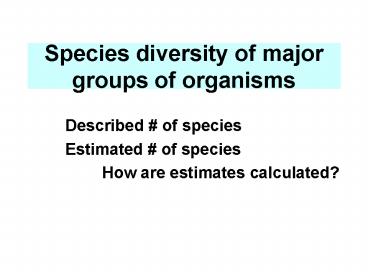Species diversity of major groups of organisms - PowerPoint PPT Presentation
1 / 22
Title:
Species diversity of major groups of organisms
Description:
Canopy beetles are 40% of all canopy arthropods = [8 x 106] x 2.5 = 20 x 106 canopy arthopods ... arthropod species, add another 10 x 106 ground arthropods ... – PowerPoint PPT presentation
Number of Views:151
Avg rating:3.0/5.0
Title: Species diversity of major groups of organisms
1
Species diversity of major groups of organisms
- Described of species
- Estimated of species
- How are estimates calculated?
2
1.65 million described species
3
Estimates of Total Species Diversity
4
Methods for estimating total species diversity
- Extrapolation from expert estimates and rates of
species descriptions - (e.g. Wilson)
- Extrapolation from thorough collection of one
taxon at one site - (e.g. Erwin)
5
Estimates of total species diversity
extrapolation from expert opinion
6
Extrapolation from diversity of one taxon at one
site
- Technique developed by Terry Erwin of Smithsonian
Institution - Used canopy fogging technique on Luehea seemannii
in Panama - Found 1200 total beetles
- Knew that 162 were specific to Luehea
7
Assumptions
- 50,000 tropical tree species, each w/ 162
host-specialist beetles 8 x 106 beetle species - Canopy beetles are 40 of all canopy arthropods
8 x 106 x 2.5 20 x 106 canopy arthopods - 2x as many canopy as ground arthropod species,
add another 10 x 106 ground arthropods - 10 x 106 10 x 106
30 x 106 total arthopod
species
8
Global species diversity
- We dont know the actual of species
- best guesses vary by an order of magnitude
- Cost of describing species
- Cost of not describing species
9
Evolution and Natural Selection
- The generators of biodiversity
10
Why is an understanding of evolution critical
for understanding biodiversity?
- All organisms have evolved to present state from
earliest single-celled living organisms - Species differentiate from each other via the
process of evolution by natural selection
11
Theory of evolution
- Charles Darwin (1809 -1882)
- Darwin biography
- Trip to South America aboard ship--published
Voyage of the Beagle - Returned to England to develop ideas
- Published Origin of Species in 1859
12
Darwin proposed the theory of evolution by
natural selection
- Made observations
- Inferred relationships
- Used logic to arrive at conclusion
13
Definitions
- Principle of common descent--all living organisms
descended from common ancestor - Natural selection-- differential success in
reproduction - Fitness--having features that allow survival to
produce offspring that reproduce
(context-dependent) - Adaptation--n. A feature of an organism that
confers fitness v. the process of acquiring such
a feature through evolution by natural selection
14
Darwinian Logic
- Observations
- Normal levels of fertility lead to exponential
population increase. - Most populations normally stable (except for
seasonal fluctuations). - Natural resources are limited.
- Inference 1
- Production of more individuals than the
environment can support leads to a struggle for
existence among individuals of a population
15
Darwins First Conclusion
- Only a fraction of offspring born in each
generation survive to reproduce. - The survivors are, by definition, fit.
16
Darwinian Logic II.
- Observations
- Individuals in a population vary
- Much variation is heritable.
17
Inference 2
- Individuals whose inherited characteristics fit
them best to their environment are likely to
leave more offspring than less fit individuals.
18
Inference 3
- Unequal ability of individuals to survive and
reproduce leads to a gradual change in a
population, with favorable characteristics
accumulating over the generations.
19
Natural Selection
- differential success in reproduction
- contrast to artificial selection, or selective
breeding of plants and animals to achieve desired
characteristics - product of natural selection is adaptation
- Natural selection occurs from the interaction
between the environment and the inherent
variability in a population. - Variations in a population arise by chance, but
natural selection is not a chance phenomenon
since environmental factors set definite criteria
for reproductive success.
20
Inference 1
21
production of more individuals than the
environment can support leads to a struggle for
existence among individuals of a population
22
(No Transcript)































